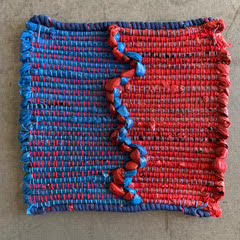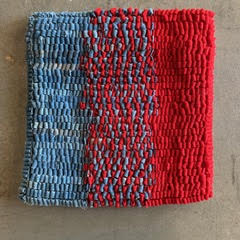It’s gonna take a lot of work to unify our country, no matter the platitudes and empty promises that are likely to come out of Washington this election year. No wonder artivism — art plus activism — is flourishing as a crucial voice in our national dialogue. Ann Morton is not only a dedicated artist, but also a woman who lets her actions as an artist speak to her concerns — and the country’s divisiveness is foremost on her mind.
In that spirit, the Phoenix-based Morton has drawn from her previous successes in public-engagement art to mount an ambitious textile project called Violet Protest. It’s a project that’s meant to get Washington’s attention, as every member of Congress will eventually get a portion of the massive artwork.
Violet Protest gets its name from this sequence of ideas: the colors red and blue have come to symbolize our two-party system, red and blue when combined become violet, and red and blue can surely coexist in a harmonic state of “violet” if only we let our leaders know it through peaceful protest. Morton is essentially crowdsourcing the making of Violet Protest, and its participants are of every political persuasion and from all over the country. At completion, it will consist of 26,750 eight-by-eight-inch squares using equal parts of red and blue that will be configured into vibrant and, yes, violet stacks of mini textile artworks spelling out “U S” when viewed from above.

Red and blue squares are being crocheted, knitted, sewn and otherwise pieced together by makers in every state and U.S. territory as you read this. The current number of finished pieces is close to 5,500. And BTW, Coloradans had contributed only 115 squares as of late May. (Spread the word, people!) In the spring of 2021, the anticipated 116 stacks comprising Violet Protest are scheduled to be on view at the Phoenix Art Museum in a show honoring Morton. She is the museum’s latest recipient of the Arlene and Morton Scult Award recognizing a mid-career Arizona artist. After the run at PAM, the stacks will be dismantled so that U.S. senators and representatives can each receive as many as 50 of these hand-made squares along with a letter of explanation. That action is scheduled for sometime in 2021.
Morton’s Instagram @ thevioletprotest is a great source for photos of Violet Protest makers and examples of their squares, should you be inspired to contribute. In addition, you can get a broader view of the project and its goals at violetprotest.com The deadline for finished squares is November 15, 2020.
Morton is a force to be reckoned with, as I know from previous stories I’ve written about her work. In 2013, for a project called Ground Cover, Morton rallied knitters, quilters and crocheters to make thousands of 10-inch squares that she later pieced together to cover a vacant lot in downtown Phoenix. When viewed from above, the “blanket” revealed a floral design. In 2016-17, a project called ReThanks enlisted volunteers to create 3,000 flowers from objects found in their trash and recycling bins. Morton then formed the flowers into a flowing ceiling-high tapestry, complete with notes of thanks to the city of Phoenix’s garbage crews. As for additional projects reflecting her social-practice art-making, Morton has focused on Phoenix’s homeless population, as well as the marginalization of minority groups, turmoil in the White House, and other sociopolitical concerns.

“We’re all a family under one sky.”
— Violet Protest contributor
Below is a short excerpt from my March 2020 phone interview with Morton, so that you can hear her passion for Violet Protest in her own words.
As you’ll discern, Morton wants to connect with Violet Protest makers as much as possible, through social media and newsletters. She cherishes the notes she receives from contributors. That’s part of her artistic process. In a VP newsletter from late March, as the coronavirus pandemic hit, she had this to say:
“I’ve been thinking over the last day or so of how this global virus is such a unifying event. This virus can affect anyone — rich, poor, famous or ordinary, yellow, white, black, brown — it is a great equalizer. This Coronavirus is showing us that the idea of dividing ourselves from each other is a facade — we are all in this together. So for now, we distance ourselves, but in this act of distancing, we are caring for each other. Maybe this sequestering will help us think about what this all really means for each one of us in our own particular situation. And of course — a chance to make squares!”




